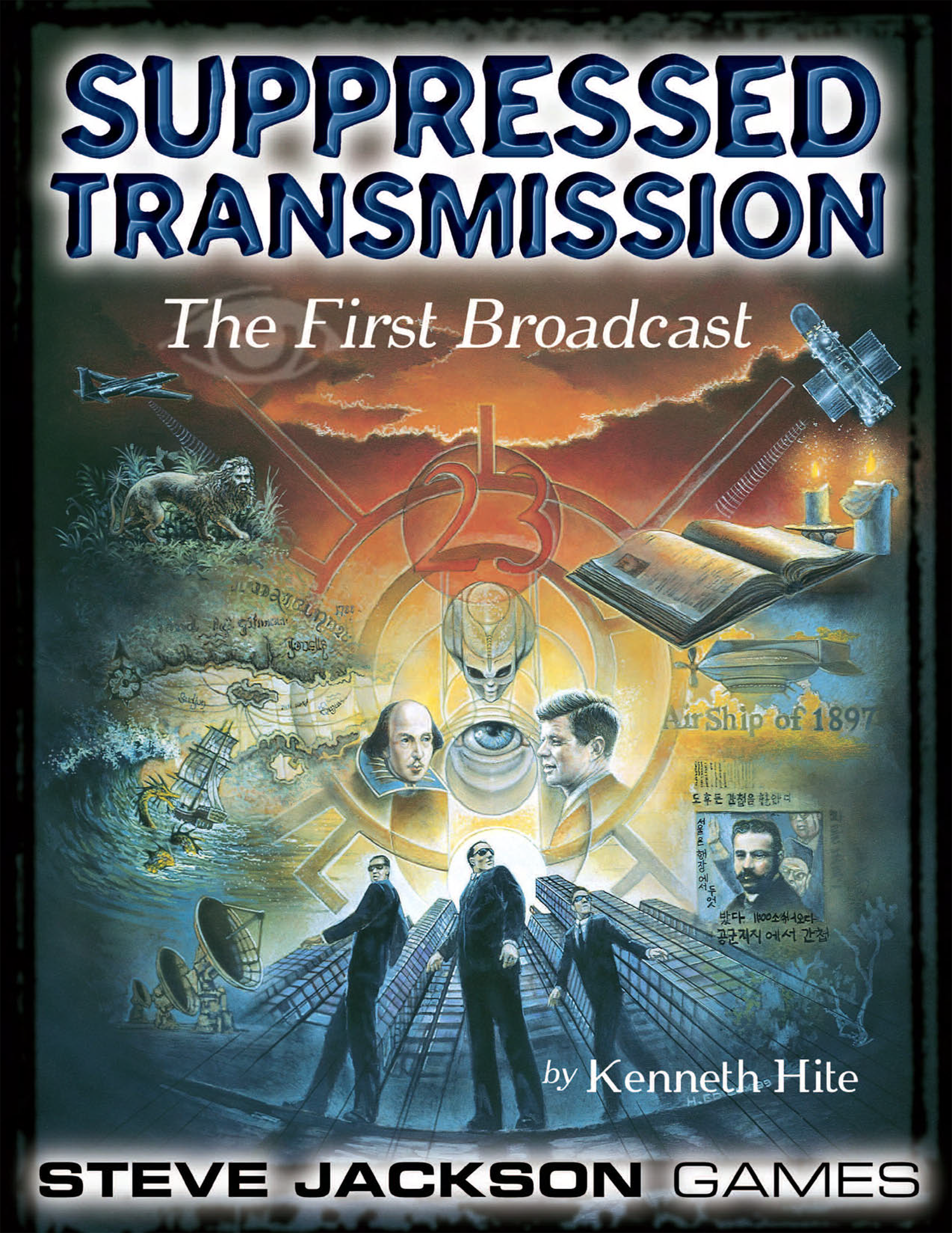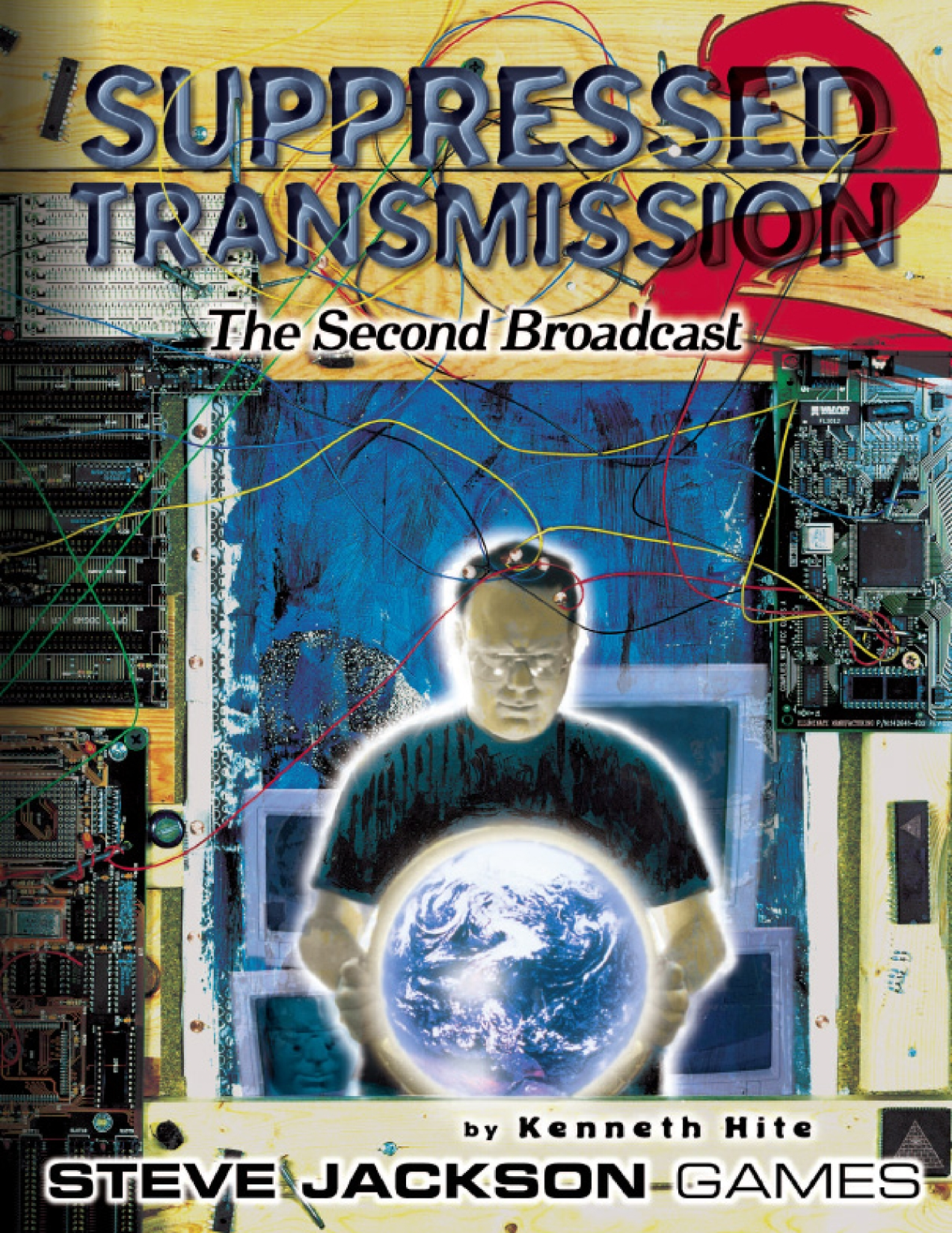 On April 3rd, 1998, a new column appeared in Pyramid Magazine for the first time: “Suppressed Transmission” by Kenneth Hite.
On April 3rd, 1998, a new column appeared in Pyramid Magazine for the first time: “Suppressed Transmission” by Kenneth Hite.
Let’s unpack this.
Pyramid, which premiered in 1993, was a gaming magazine published by Steve Jackson Games. It had been preceded by the legendary Space Gamer (1980-85) and Roleplayer (1986-93). The original Pyramid ended its run in March 1998, but only because SJG was taking the unprecedented step of offering Pyramid as a subscription website.
Today, this is likely to elicit little more than a shrug. At the time, though, it was a hugely controversial decision. Pay money?! For a website?!
But Pyramid was the last of the generalist RPG magazines. (Dragon had finished its transformation into a complete house organ. White Wolf and Challenge were already gone. Shadis would be out of print by the end of the year.) Going to an online subscription model would allow it to survive. And survive it did, each week delivering a half dozen or so articles and reviews.
Note: Some of my earliest professional sales were made to Pyramid Magazine during this time period. Check the Bibliography for more information.
And right from the beginning, Hite’s “Suppressed Transmission” was there.
To describe Hite’s column as a “hit” honestly feels inadequate. A common “joke” at the time was that the majority of Pyramid’s subscribers were only subscribing so that they could have access to “Suppressed Transmission,” but I’m not really sure it was a joke. No matter where you were hanging out in the online RPG community, each new column would immediately spark furious discussion. It sometimes felt like we were all just waiting for the next column to drop. It rapidly established itself as something between a tentpole and a shibboleth.
Sheer popularity alone, however, doesn’t fully describe the impact of “Suppressed Transmission.” It was a huge influence for an entire generation of game designers and game masters, mainstreaming — at least in the RPG field — a slew of ideas and influences which had previously existed out on the fringe.
“You know about the suppressed transmission, of course?”
– Slacker
Okay, enough beating around the bush. What is the Suppressed Transmission?
There is, in truth, an ineffable quality to the column that can make it difficult to capture exactly what makes the column so special. But the short version is that Kenneth Hite has a voracious appetite for:
- Conspiracy
- Secret History
- Horror
- Alternate History
He takes these four elements and, like a master alchemist, mixes them into potent elixirs — “suppressed transmissions” ready for broadcasting into your campaign.
So that’s part one: Hite has collected a treasure trove of the most amazing and crazed material, and he shares it freely with the reader while inventing even more besides. For example, when the world went mad for the “truths” revealed by Dan Brown’s The Da Vinci Code, I was underwhelmed largely because Kenneth Hite had already revealed those “truths” to me… and a dozen other Grail conspiracies besides, all trussed, roasted, carved, and served up for the game table.
The second thing — and this can be quite hard to communicate to anyone who hasn’t actually read one of the Suppressed Transmissions — is the sheer density Hite achieves. Reading these columns is like having a firehose aimed at your brain. In a four-page essay, Hite can deliver mind-blowingly brilliant concepts for a dozen — or more! — full-fledged campaigns. A Suppressed Transmission collection is like a neutron star, and every paragraph neutronium.
For example, in “Six Flags Over Roswell,” Hite takes the Roswell alien crash in 1947 (conspiracy) and looks at what might have happened if the crash had really taken place at six different points in time (alternate history). Not only is every one of these variations pure gold, but for most you can just as easily frame a campaign around the event itself (PCs are Union spies racing their Confederate counterparts to investigate the crash), the immediate aftermath (psychic alien body-jumpers are infiltrating the Mexican government), or the strange other-world that results (the covert war of the Wizards of Menlo Park or the steampunk Republic of Texas).
Or all three.
In “Justinian and Arthur,” Hite introduces the concept of “high historical fantasy.” From Procopius’ Anekdota he takes the claim that Justinian and Theodora, Emperor and Empress of the Byzantine Empire, were secretly possessed by demons. Then he observes that King Arthur was essentially Justinian’s contemporary, and from Malory’s Le Morte d’Arthur he takes the Roman War in which Arthur fought an emperor who “had gotten with him fifty giants which had been engendered of fiends.” Sure, the emperor in Malory is Lucius, but that’s easily swapped out, and then:
Set [the PCs] out on the wild frontier between Arthur’s Britain and the Byzantine Empire. (No, there wasn’t any such border in Real History. I’ve got news for you; there weren’t any demons in Real History and there probably wasn’t any King Arthur, either.)
As the PCs find out more and more about Justinian’s demonic plans, they can work with Arthur’s spies, be harassed by the Unseelie Court of Morgan le Fay, and generally skulk around dodging fiend-engendered ogres Nazgul enforcer types. […] Finally, they uncover Jusinian’s plan — to find the Holy Grail and pervert it for his diabolical ends! Warning Arthur just in time, the PCs must keep the Grail safe from Justinian’s demon-giants and distract Belisarius (or convince him that Justinian is a demon; no small task given that his wife is in the same coven as Empress Theodora) so that Arthur can defeat the evil Romans and save the day. This is the sort of thing you can call “historical high fantasy;” it has the advantages of historical games (evocatively familiar and wonderful names and places, conveniently assembled background materials for research at your whim) without the disadvantages (having to do research to get things perfect, having to stay true to history, having to risk a player who knows more about the period than you do). When you add the cool fantasy trappings like giants, monsters, demons, magic swords, sorcery, and poison, you got game.
Oh, and do take the time to read Procopius. The bit with the demon-Emperor’s disappearing head is a hoot.
This is the sort of thing that Hite does all the time, taking 2 + 2 + 2 and somehow making it equal 187 (which means “the beginning of great enlightenment” in New Age kabbalism).
But it’s more than that.
As Hite takes you on wild romps like:
- Who Killed Kit Marlowe?
- A Night To Embroider: Who Sank the Titanic?
- A Dish Best Served Cold: The Antarctic Space Nazis
- Six Degrees of Francis Bacon
- Patterns in Amber
- Things To Do In Gaming When You’re Dead
The real suppressed transmission — the transmission hiding within the transmission — is that Hite is showing how he creates campaigns and adventures. Every column is an exemplar of how he sources material and then combines it, twists its, inverts, bissociates it, and builds upon it to create pure gaming gold.
As you work your way through a Suppressed Transmissions collection — and I do recommend taking it slowly; this is material best savored rather than binged (no matter how tempting the binge might be) — you can feel Hite reprogramming your brain.
And we haven’t even gotten into his alphabets (here’s 26 bite-sized, themed bits of awesome to inspire your adventures) or his how-to essays that peel back the curtain to look at each of the four pillars of Suppressed Transmissions (conspiracy, alternate history, secret history, and horror) in detail.
 It will probably come as no surprise at this point to learn that I consider “Suppressed Transmission” to be a major influence on me as a creator and as a GM. Despite this, until recently, I haven’t talked about the column very much. The primary reason for this is that it simply wasn’t available: When the online version of Pyramid was shut down in 2008, the archives became unavailable and the published collections went out of print.
It will probably come as no surprise at this point to learn that I consider “Suppressed Transmission” to be a major influence on me as a creator and as a GM. Despite this, until recently, I haven’t talked about the column very much. The primary reason for this is that it simply wasn’t available: When the online version of Pyramid was shut down in 2008, the archives became unavailable and the published collections went out of print.
Sadly, for the most part, this remains true. Hite wrote over three hundred “Suppressed Transmission” columns, and the vast majority of these remain available only to those of us who were subscribed to Pyramid in its final days and downloaded the archives before they were taken offline.
But at some point in the not-too-distant past, Steve Jackson Games has brought Suppressed Transmission: The First Broadcast and Suppressed Transmission 2: The Second Broadcast back into print. These two collections include several dozen of the original columns, each of which has been festooned with detailed footnotes and extensive commentaries that somehow manage to make them even more awesome.
In conclusion…
… what the heck are you waiting for?
Grade: A+
Author: Kenneth Hite
Publisher: Steve Jackson Games
Price: $29.99 (each)
Page Count: 128 (each)












This is definitely going one my must buy list.
Though looking around I found that Warehouse 23 is selling $9 pdf copies of these, which are a lot easier to fit in the budget
https://warehouse23.com/search?q=suppressed+transission&options%5Bunavailable_products%5D=show&options%5Bprefix%5D=last
It’s a pity the digital edition is no longer available (404). I’d love to get my hands on these, but I don’t want to buy them from Amazon :-/
Jay: you could get the PDFs that Jason linked and then print them yourself, perhaps?
I do hope that more of these are made available. The first two volumes are great, and seeing more from later years would be wonderful.
Wait, hoards of people only read Pyramid (v2) for Suppressed Transmission? We must travel in vastly different crowds; I hardly ever looked at it, and I know I’m not alone among subscribers. I always figured that most Pyramid subscribers were GURPS fanboys, even then. That’s what always got the traction in the internal forums.
Slightly besides the point, but my attention was caught by Pyramid being called the last of the generalist magazines. I’m a longtime reader of KenzerCo’s Knights of the Dinner Table magazine and while there are a couple of reasons why it could be excluded from the group of “generalist” magazines (it’s main claim to fame is its ongoing comic strips; it’s owned by a gaming company that publishes and advertises their own content amongst material for other systems), I know a lot of the readers value it for being, in their minds, the last the last one in that group.
@Phil: A complete history of RPG magazines is probably a little beyond scope here.
Short version:
1. A couple years after Pyramid went digital, there was a brief resurgence of RPG magazines. (Most of which then died in 2003.)
2. This included Knights of the Dinner Table… sort of. The comic book was first published in ’96, but for several years it really was just comic.
I tried to identify which exact issue had the Blackburn editorial basically saying, “Hey! We’re expanding this into a magazine!” My method of “randomly flipping through issues” hasn’t panned out, but I’m pretty sure this was also around 2000. In any case, that’s the time period where KODT began adding a lot of non-strip related content and expanded into what I’d consider a true magazine.